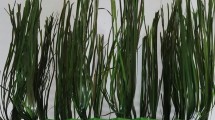Abstract
WHILE the alarm reaction in fish is believed to be produced by a chemical substance (pheromone) secreted by specialized cells in the epidermis and released by epidermal damage, relatively little systematic research has been devoted to the extent, nature or essence of the reaction and its relationship to the relevant chemical substance1. Our investigation represents an exploration of the effect of alarm pheromone on avoidance conditioning. Fifteen 2 inch goldfish, Carassius auratus, were kept in a thirty gallon aquarium divided into thirds by wire barriers. In accordance with other reports, the fish were deliberately well fed2. Massed avoidance conditioning (all trials on one day) was studied in a Lafayette Instrument aquatic conditioning unit (volume of approximately one gallon; inside dimensions, 3.5×6×9 inches). Lights at each end of the conditioning tank served as the conditional stimuli (CS) and electric shock as the unconditional stimulus (US). Shock was adjusted for each fish and varied from 5 to 7 a.c.
This is a preview of subscription content, access via your institution
Access options
Subscribe to this journal
Receive 51 print issues and online access
$199.00 per year
only $3.90 per issue
Buy this article
- Purchase on SpringerLink
- Instant access to full article PDF
Prices may be subject to local taxes which are calculated during checkout
Similar content being viewed by others
References
Gleason, K. K., and Reynierse, J. H., Psychol. Bull., 71, 58 (1969).
Thinnes, H., and Vandenbussche, E., Anim. Behav., 14, 296 (1966).
Author information
Authors and Affiliations
Rights and permissions
About this article
Cite this article
KIMBRELL, G., WEINROTT, M., MORRIS, E. et al. Alarm Pheromone and Avoidance Conditioning in Goldfish, Carassius auratus . Nature 225, 754 (1970). https://doi.org/10.1038/225754a0
Received:
Revised:
Issue date:
DOI: https://doi.org/10.1038/225754a0



